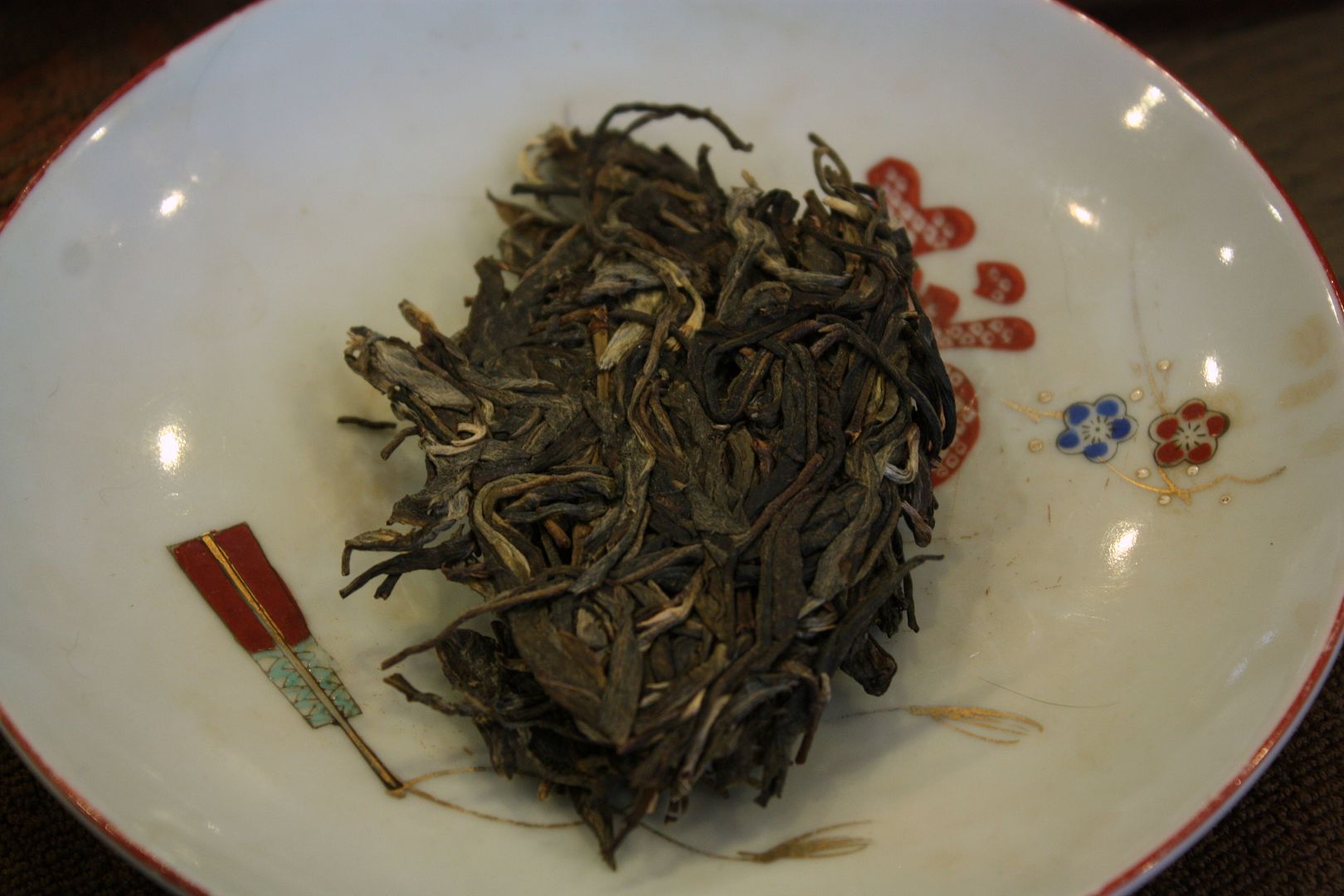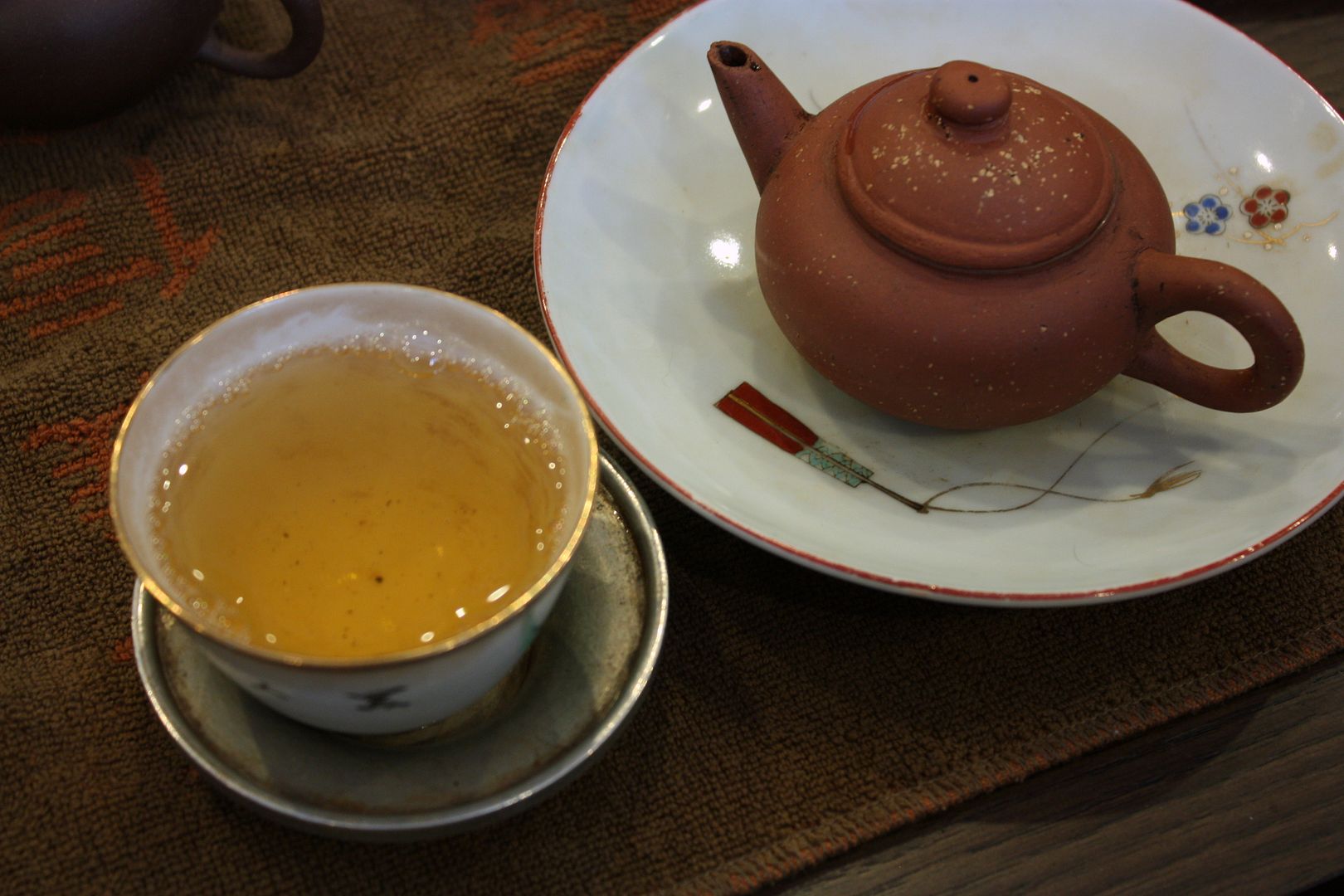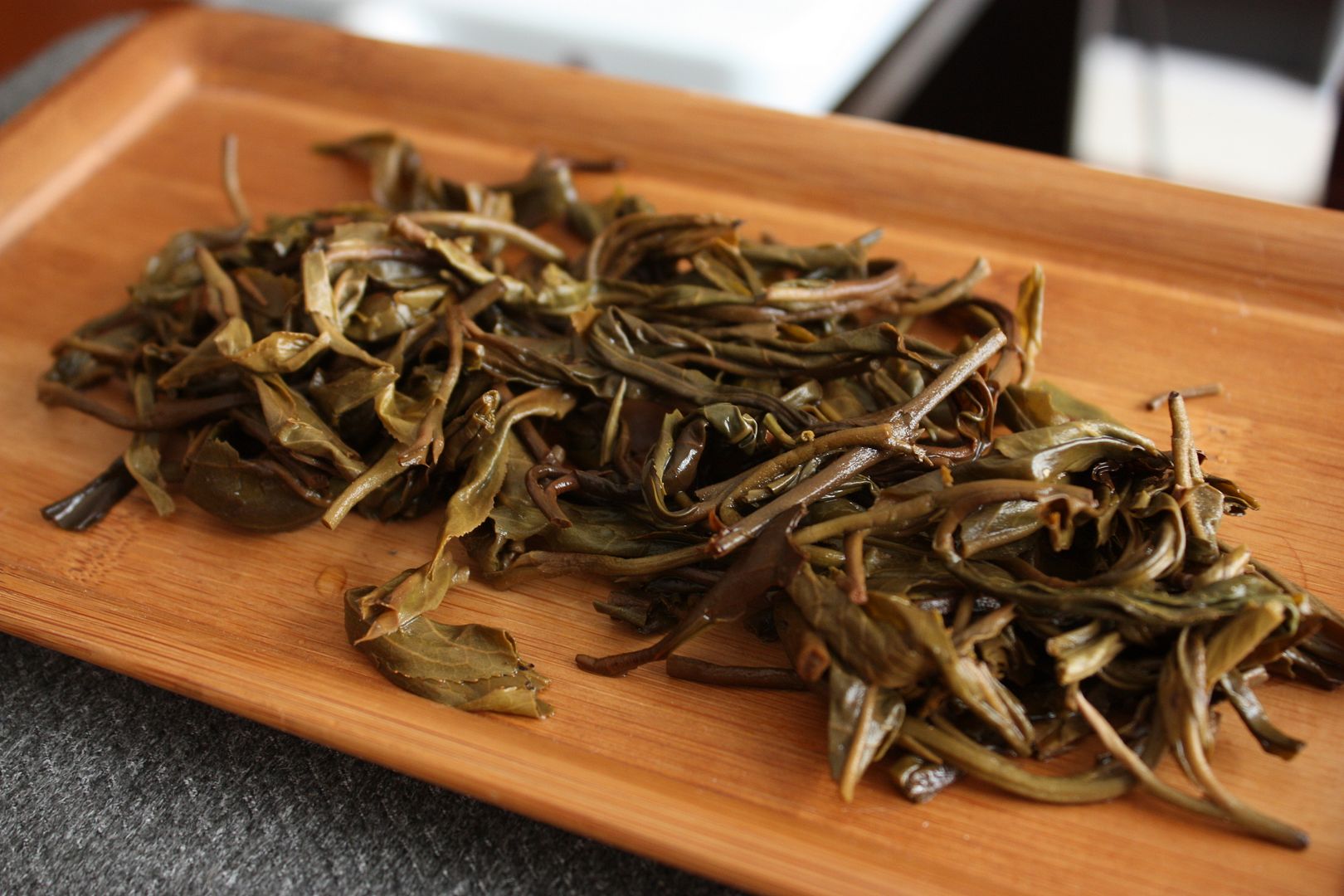I recently had a sample exchange with Eugene, writer of the Tea Urchin blog and owner of the webstore of the same name that sells young puerh, many of which with maocha he sourced himself. At the time, I wasn’t aware that the store was already open for business, so I asked if I could buy some samples. We ended up trading tea instead, with me supplying some teas from my own stash, and him giving me a pretty generous haul of tea from his various offerings. I think I made it out of this exchange in the positive.
The range of teas that are new and available is vast. They can go from the most run of the mill mass produced teas, to high end, hand made, old tree teas. There are, of course, a great chasm between the two, and unfortunately many of the old tree teas actually properly belong to things that are in between, or even wholly on the mass produced side. I have heard many stories of tea farmers selling adulterated maocha to people, mixed with different kinds of teas, and unless you really know what you’re doing, very often such mixed teas or even more inferior ones will make it into erstwhile old tree cakes. Clearly, the offerings from the Tea Urchin, at least those of his own pressing, are at the high end of the market.
Although this is the first time I’m writing about Tea Urchin’s tea, this isn’t the first sample I had. I already drank four or five of them, and for this 2011 Fall Gaoshanzhai, I tried it twice. I’m not myself a great fan of fall teas these days, and will generally try to avoid them if there’s something available from the spring. In this case, however, a sample can’t hurt.
The leaves are certainly good looking, and they look robust and thick, which is a good sign.
The tea itself also brews a nice, thick liquor, with a good aroma that is straight out of Gaoshanzhai, which is probably my favourite Yiwu village in terms of aroma, even though Guafengzhai teas are often better overall. The tea, I think, really is quite good. The first time I used lots of leaves, the second time less, and I think in some ways, using a little less leaves does bring out the higher notes more, although for the physical sensations of drinking the tea, a heavier dose is often preferred.
Prices for old tree teas have been going one way only – up. This year the prices of maocha has gone up yet again, partly due to a drought in Yunnan, supposedly, but mostly I think has to do with the insatiable demand for such teas. Another problem, of course, is that many so called old tree teas are anything but, sometimes with a small mixture of lesser leaves, sometimes it is an outright fraud. I think in this case, the tea does show what I understand to be old tree teas. Prices here, of course, also reflect that. Unfortunately, you can’t really find decent Yiwu teas at anything less than about $80 USD a cake these days.
Now that samples are easily available from his website, I think it’s worth your time to try it out. $7 for 30g is not terrible, and you can do a lot worse than this if you’re looking for a young puerh.




 RSS - Posts
RSS - Posts
20 responses so far ↓
Neil Gorman // April 19, 2012 at 11:19 am |
This was an awesome post. I was totally unaware of Tea Urchin, but now (thanks to this post) I’ll e ordering from them soon.
Thanks again for taking the time to contribute to the tea drinking community with this blog!
-N
Denny // April 19, 2012 at 3:40 pm |
Hmm tea look nice, but 2011 fall is price for this village not more than 40USD (250RMB) per kilo pure big tea trees 🙂
MarshalN // April 19, 2012 at 11:41 pm |
I never said the tea is cheap. Having said that, I haven’t kept up with prices for all the villages out there. From what I understand though, the price you’re quoting here is the same price circa Fall 2006. Are your sources making any distinction between big tree and old tree?
shah8 // April 20, 2012 at 10:40 am |
GFZ old tree for the spring of 2012 is something like $200+/kg. It is extremely unlikely that, as a whole, and not any particular spot pricing (might have rained just then), that GFZ old tree in the Fall of 2011 would be a fifth of the spring price.
shah8 // April 20, 2012 at 10:46 am |
Oops…
Gaoshanzhai…well, that I wouldn’t know. I would probably say that $40 does sound like eco-tea pricing. It’s about 5-6 times the price of generic good Menghai plantation, and yeah, that still sounds like 2006 Fall pricing (which was part of the bubblicious era).
MarshalN // April 20, 2012 at 10:51 am
As far as I’m aware old tree teas never got back to 2006 prices. Not even close. The bubble collapsed in MH and XG, not this stuff.
shah8 // April 20, 2012 at 11:28 am
I think old tree prices did fall.
There are a number of unusually good fall ’07 old trees out there. Also, in ’08 and sorta in ’09, XZH, HLH, and others offered fewer teas than they did in ’07. There were numerous references to LBZ prices meeting and exceeding the ’07 records. Lastly, outside of Banna and a few other special places, old tree tea didn’t really start getting valuable until ’09 and ’10.
I think it’s better to say that old tree tea slumped for 1.5 years, rather than crashed. Dayi tea prices certainly have recovered, and oh hey! Fujin’s doing quite well too!
MarshalN // April 20, 2012 at 11:37 am
They never fell in the way the bubble teas fell – sure, things calmed down a bit, but it was not like an 80% discount, if you catch my drift. Things also recovered pretty quickly.
Denny // April 20, 2012 at 4:09 pm |
Have you visited Gaoshanzhai before ? There is two kind picking – “dashu” and “xiaoshu” , and you can find family who have good old tea trees garden and watch all the procesing of mao cha.
2006…2007 price,,,is not the same. 2008 and 2009 are pretty cheap years, much more than 2006. Last year coz rain, not have many people want to buy fall material. The price was 250rmb for this village. This year spring is 500rmb for blend xiao and dashu (farmers not select xiao shu), and 650 and sometimes 700rmb for big old tea trees.
GFZ is of course big different in price.
Eugene // April 20, 2012 at 11:41 pm |
Maocha prices vary according to the weather, the farmer, and the trees selected. When I first visited Gaoshanzhai in August of last year, the price was 320/kilo for rain affected gushu maocha, I visited again in October after 5 days of sunny weather, and the price was 400/kilo. If you want to pick specific trees eg. all large trees, then you can expect to pay even more. If you want something special eg. just one bud and two leaves, more again. The farmers (or chu zhi suo) who produce better tasting maocha add a premium too. So the price really depends on when you buy, what you buy, and who you buy from.
Denny // April 21, 2012 at 1:02 am |
Ok, so you pay price 400 for autumn Gaoshanzhai. Hmm i call today morning to friend from there and he say , yes, of course is possible, if you accept price which the farmer want. Some family sell this year few kilos with 1000rmb+, but of course 1000rmb is not price for Gaoshanzhai gushu, just some people accept price which farmer try to say. Better just some local “maocha helper” who can talk about price better.
Last spring maocha is 400+ rmb to 500rmb for extra select tea. Normal is 40-50% down, so price 250 is logical and we also buy few kilos fall 11´ from one day picking which we see in all process, of course gushu, in middle October when we go there.
MarshalN // April 21, 2012 at 6:18 am |
Interesting discussion. Denny, you use “we” to talk about your going to Yunnan. Could you tell us who this “we” is, and where we can get our hands on your teas?
Denny // April 21, 2012 at 7:01 am
I am not tea seller, but buy tea for myself with my friends. So I am not some tea rival, just I like Gaoshanzhai tea and go there every spring and sometimes autumn too. Also pick good quality maocha, so not need lie to here. If the tea is good, all price okay 🙂 Just I saw my opinion coz some your last posts are about price for tea etc. But I not drank the tea from Tea Urchin, maybe is not so fair talk like this. Peace
MarshalN // April 21, 2012 at 7:06 am
Ah, I was more talking about the prices of older teas anyway. Young teas – pricing is all over the place, and is quite chaotic. I think it has more to do with which market the tea is targeting and what they are after.
Are you based in China? If you care to share, I’d love to try some of your teas 🙂
Denny // April 25, 2012 at 7:52 pm
I am in Chongqing, if you travel to here, you are welcome. Or if you like Gaoshanzhai you can maybe travel with us there or other places in Yiwu, i said before we not do tea business so also you can see the price and quality of tea which we buy there yourself. Just contact me before to email. Denny
Hobbes // April 20, 2012 at 6:06 am |
I did exactly the same thing – asked to buy, ended up trading. 🙂
I was less pleased with the majority of the “Charen” Tea Urchin productions from this year, but I am holding off from publishing my opinions to give Eugene a chance to reply to my comments via e-mail, in the name of fairness.
I very much enjoyed those cakes from “Mr. Gao” (which seem to have disappeared from the company’s web-site) and Xinshengli (to a lesser degree).
All the best,
Hobbes
MarshalN // April 20, 2012 at 10:32 am |
While it’s not the best tea I’ve ever had, I don’t think it has any major flaws. Coming from you, I’d suspect your problem with it is probably that it’s “brown”, whatever it means. I think in a few years time though you’ll find this tea to be quite decent.
If anything, I find the Mr. Gao tea to be fair, but not great. There are far better at that age.
michele // April 25, 2012 at 6:20 pm |
I also never heard of the Tea Urchin. Glad you posted about it. The price of tea cakes is high but worth it.
Bev // May 4, 2012 at 12:46 pm |
Between the GaoShanZhai and the GaoFengZhai, I found the Shan much stronger in terms of mouth activity and hui gan. The Feng wasn’t bad, and was felt lower in the belly, but if pressed to choose I’d go with the Shan. I just found it a little more interesting. The Feng also had some smokiness going on and I have to wonder — did the extra smoke it received perhaps diminish it’s strength a bit? I’m just working on a hunch with that, but am wondering what you think.
shah8 // May 5, 2012 at 9:38 pm |
The main reason Guafengzhai is the dominant Yiwu is because it’s the highest elevation Yiwu (and has that throatiness that high elevation puerh possesses) and the Yiwu with the strongest qi. Remember that Chen Guanghe Tang Fall ’06 you liked so much? Why you liked it so much? That’s an inferior/mediocre example of GFZ. Imagine what a full-bore example would be like if it was from Spring ’06! That’s why I bought one of Nada’s GFZ cakes last year. Just frustrated because at 200g, I definitely can’t be sampling at will. Will Power!